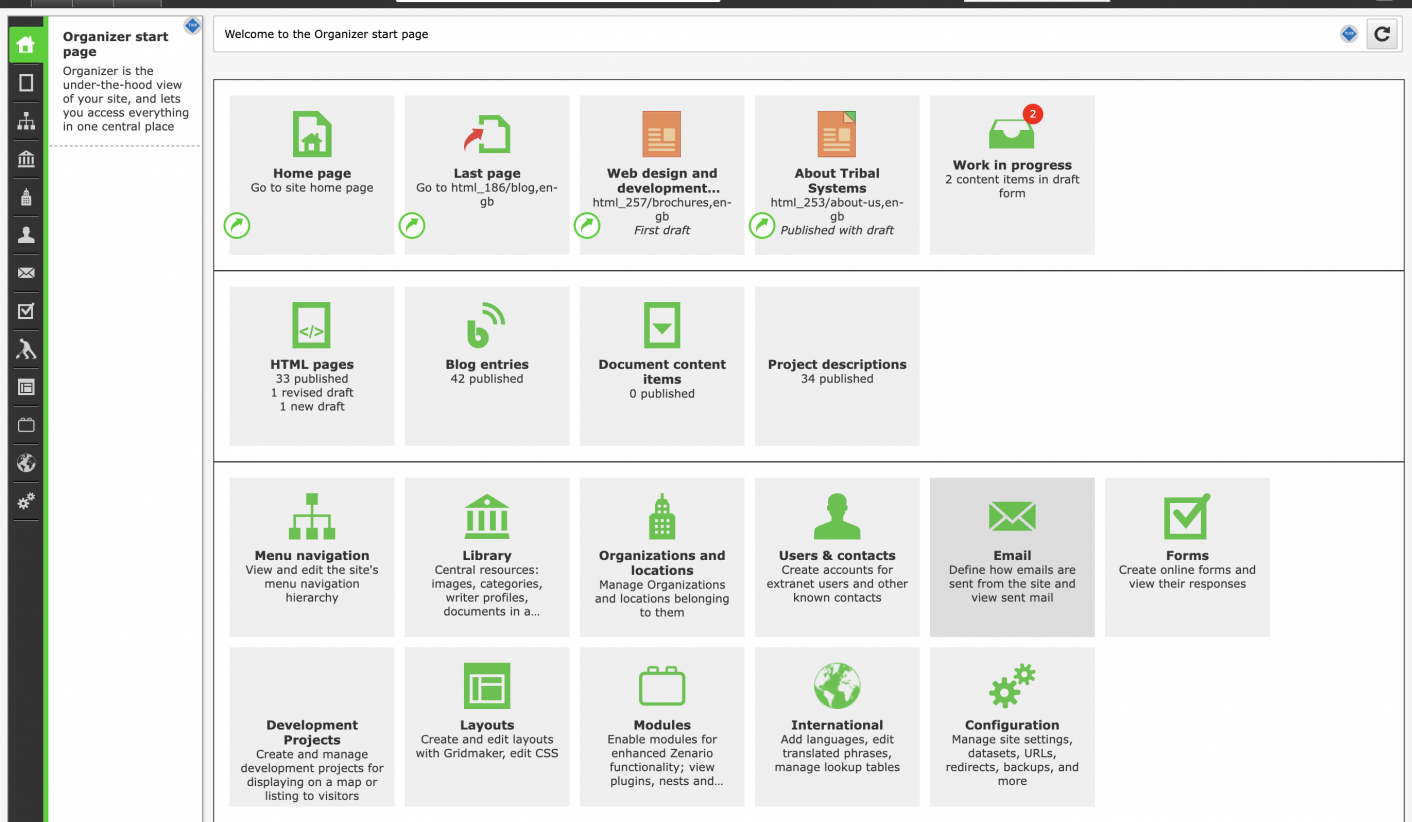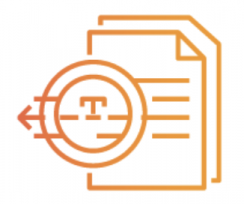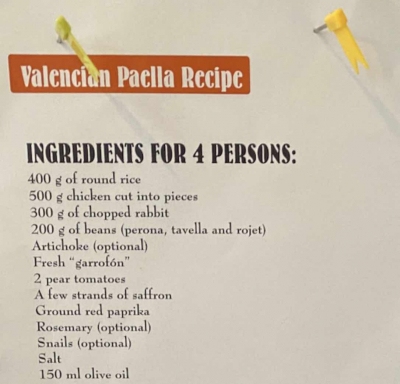 Zenario 9.7
Zenario 9.7
Zenario 9.7 was released in January 2024, and includes a range of improvements.
In summary, there is a much smoother administrator experience overall, and we're making preparation for our forthcoming machine learning and AI features.
Organizer
There is now a greatly-improved Organizer Start page. This lets administrators get more quickly to a range of key areas of Organizer.
Here's a sample of how it will look:

The first row contains links to the home page, the last page visited, and the draft pages. There are then individual links to each content type, followed by links to key areas of Organizer.
Editing
We have made more major updates to our WYSIWYG editors. The editor layouts are now more consistent across the whole of Zenario, with appropriate variants according to whether they are in-line editors, summary editors, email editors, or simple description editors.
Here's an in-line editor example:

When uploading an image while using a WYSIWYG editor on a public page or email template or newsletter, the image is now automatically made public, with a growl message visible to the administrator.
Image privacy
We now have a stronger concept of images being "public" or "private". Up until Zenario 9.6 it was more like "public" or "unlisted".
"Public" images had a fixed URL (including a 5-character code in the path), while "unlisted" images did not have a fixed URL (and therefore were not indexible on sites like Google Images).
On Zenario 9.7, "unlisted" has become "private", and the statuses are more clearly enforced. It will no longer be possible to put a private image on a public content item, and any such images will no longer be displayed (and there will be a warning to admin's when loading a public page with private images).
In a typical site, almost all images are public anyway, so this only affects sites where it is intended that some images are held back from public view — such as an image gallery in an extranet area, which may be a page with a Multiple Image Container plugin.
So when editing a publicly visible page, or an email template or newsletter, and the editor adds an image, that image will automatically be made public, with a toast message to say so.
This keeps the system easy to use, easier to understand, and gives more explicit control for situations when certain images should truly be kept private.
Option: Amazon Textract text extraction

To date, Zenario has used third party libraries such as pdftotext to scan document content items and other files for text. This has worked pretty well, but the process has a few issues with special characters, and does not work at all with PDFs that lack a text layer, and with images.
We have created the ability for Zenario to scan PDFs, JPEGs and PNGs using Amazon Textract. This gives vastly more accurate results. It handles accented characters more accurately, and performs OCR (optical character recognition) on documents which are images without a text layer.
Here's a tiny example using an image:
| Original image | Scanned text | |
|
|
» | Valencian Paella Recipe INGREDIENTS FOR 4 PERSONS: 400 g of round rice 500 g chicken cut into pieces 300 g of chopped rabbit 200 g of beans (perona, tavella and rojet) Artichoke (optional) Fresh "garrofón" 2 pear tomatoes A few strands of saffron Ground red paprika Rosemary (optional) Snails (optional) Salt 150 ml olive oil |
The scanning takes a little time, and so is only initiated in the Organizer panel, and then completed asynchronously. New documents are scanned automatically, and existing documents can be re-scanned in this way. It is tied to a scheduled task, and so takes typically 1-3 minutes to get the result.
In conjunction with this, there is now a better site settings panel for connections with Amazon's AWS services. This exists already for storage of documents on Amazon's s3 service.
For Zenario managed hosting customers, we will be offering this as a paid upgrade.
For people downloading Zenario, the feature will be included, but note that you will need an AWS account to enable it, and you will need to pay the Textract and associated AWS fees.
Admin toolbar
The admin toolbar has been slimmed down, now with less buttons than before, as some of them were redundant.
The admin toolbar has also been improved for use on narrow screens, such as small laptops.
Languages and phrases
An improvement for multi-language sites, we have re-organised how visitor phrases are tracked in the Organizer panel. You now see the content item they were first used on, and when they were first seen in visitor mode. This helps to understand the context of where a phrase is used so it can be been in-situ.
Review language system, we have updated how "detected language codes" work. So when starting a new language or editing an existing language (in Organizer->International) to set the possible language codes which will be detected by Zenario:

Improvements for handling plain text vs. HTML in the phrases system. There is now an indicator of whether a phrase is plaintext or HTML.
Videos Manager
![]()
The Videos Manager module now integrates with Advanced Search, so that when a visitor uses the Advanced Search plugin, it can search in videos.
Also we have speeded up the loading of the videos panel in Organizer, which could be slow to load with over 1,000 videos stored in a Vimeo-based library.
Privacy information from Vimeo is now cached in Zenario, so the whole process is now fast like the rest of Organizer.
Users
Password fields that appear to users can now show a hide/show password field in the form of an "eye" (or which may be customised for each site skin).

There is better control over the "email verified" flag for users and contacts.
When selecting a user or contact account, there is now a "Send verification email" button, which causes an email to be sent from Zenario to that person, with a special verification link. This previously only happened silently in the registration process and some other processes, but was not so explicit.
We have tidied up the verification hash fields which are used when a user registers and verifies their email address, and when they are an existing user and change their email address.
On the various extranet plugins, we have centralised and simplified the CSS classes that are used.
Content Summary List plugins
Content summary list (CSL) plugins are a convenient way to show news or blog articles, as they can easily be set up to show most recent items first.
There is now a "New" class which can be attached to items in a CSL where they have release dates in the past few days or weeks.
Hidden content items
When using a CSL and it contains content items that have a status of "hidden", they are now shown to administrators, but are still hidden from visitor view.
This helps administrators visualise a new, draft page with a CSL, without having to publish the items that will appear on the list.
The site settings panel in Organizer for Email and newsletter settings now has a tab called "CSS rules". This allows CSS rules to be applied for all emails. This was previously done on an individual email template basis, and so any settings were not easy to standardise.
The preview box of email templates and newsletters now correctly show the CSS styles. So you can more accurately see how nicely an HTML-based will appear.
On admin login 2FA screen, if there is a problem sending an email — for example, because of an SMTP issue from the server — there is now an informative message to show the error that Zenario encountered.
Forms
Forms have been improved, in terms of handling responses from visitors/users.
It is now possible select a form response and email it again.
Also, it is now possible to have a flag on each response to say that that particular response has been allocated to a particular administrator for handling. Zenario notes which administrator "takes" the response, so other administrators can see who is handling it.
There is now better escaping on form labels and other items in the form editor.
Search — change from Search Entry to Advanced Search
We have now deprecated the Search Entry Box and Search Results modules (zenario_search_entry_box and zenario_search_results).
These are now in the zenario_extra_modules directory which is available to hosted customers but not normally made available for download.
You should remove these from your Modules area, and install the far superior Advanced Search module (zenario_advanced_search). This is best installed using two modes:
- an inline search mode in the site-wide header area of every page, or in the upper area of most layouts
- a full page search and results mode, in the body of a Search content item.
Database table engine
We have re-applied an earlier change, to change the table engine from MySQL's MyISAM engine to the newer InnoDB engine.
This had previously been optional but we encountered problems on some customer installations to do with certain tables (spare aliases, layouts).
Various other improvements
When duplicating a content item, the administrator can no longer pick a retired layout for the new item.
We fixed a bug which was preventing search from working properly in hierarchical views (e.g. hierarchical documents, menus).
Admin permissions: deleted data from trashed admin accounts; improved copying.
Moved functionality of content item error log to common features.
Document container plugins now have improved options for showing thumbnail image of the document.
There was a bug in the Advanced Search plugin whereby the cache could be cleared when a visitor runs a search.
For the Zenario cache, we have made a site setting to enable sending of an email when the cache is cleared. This should help module developers.
The menu tree hierarchy view has been removed.


